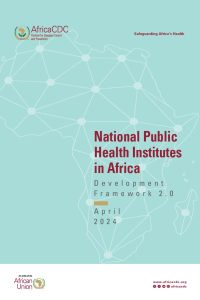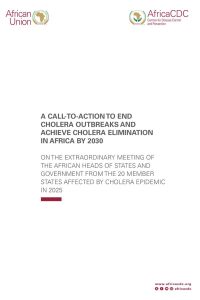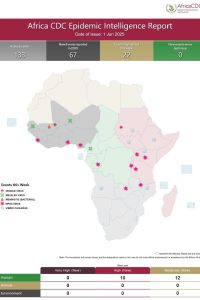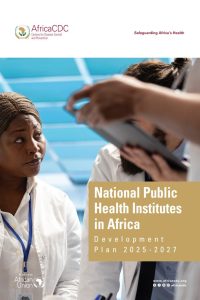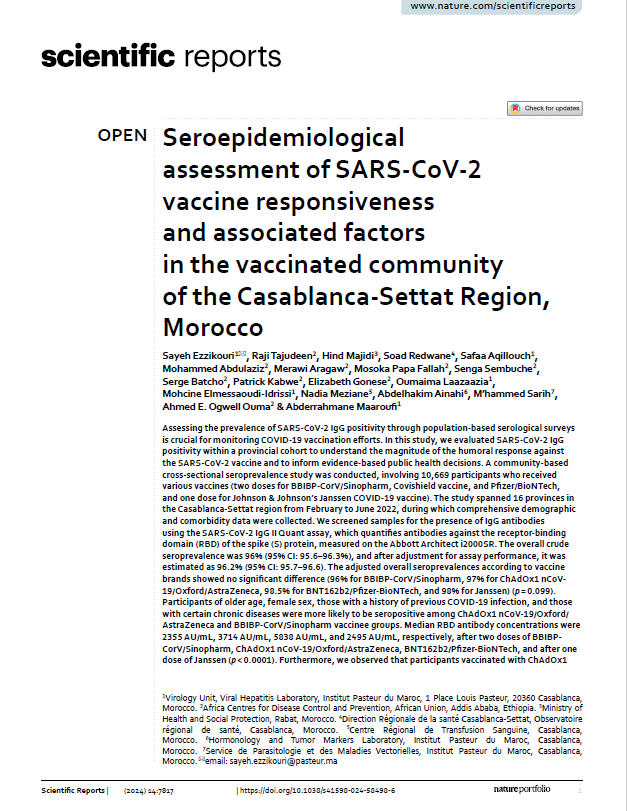
- Version
- Download 1203
- File Size 4.67 MB
- File Count 1
- Create Date 2 May 2024
- Last Updated 2 May 2024
Sero-epidemiological assessment of SARS-CoV-2 vaccine responsiveness and associated factors in the vaccinated community of the Casablanca-Settat Region, Morocco
Sayeh Ezzikouri, Raji Tajudeen, Hind Majidi, Soad Redwane, Safaa Aqillouch, Mohammed Abdulaziz, Merawi Aragaw, Mosoka Papa Fallah, Senga Sembuche, Serge Batcho, Patrick Kabwe, Elizabeth Gonese, Oumaima Laazaazia, Mohcine Elmessaoudi-Idrissi, Nadia Meziane, Abdelhakim Ainahi, M’hammed Sarih, Ahmed E. Ogwell Ouma & Abderrahmane Maaroufi
Abstract
Assessing the prevalence of SARS-CoV-2 IgG positivity through population-based serological surveys is crucial for monitoring COVID-19 vaccination efforts. In this study, we evaluated SARS-CoV-2 IgG positivity within a provincial cohort to understand the magnitude of the humoral response against the SARS-CoV-2 vaccine and to inform evidence-based public health decisions. A community-based cross-sectional seroprevalence study was conducted, involving 10,669 participants who received various vaccines (two doses for BBIBP-CorV/Sinopharm, Covishield vaccine, and Pfizer/BioNTech, and one dose for Johnson & Johnson's Janssen COVID-19 vaccine). The study spanned 16 provinces in the Casablanca-Settat region from February to June 2022, during which comprehensive demographic and comorbidity data were collected. We screened samples for the presence of IgG antibodies using the SARS-CoV-2 IgG II Quant assay, which quantifies antibodies against the receptor-binding domain (RBD) of the spike (S) protein, measured on the Abbott Architect i2000SR. The overall crude seroprevalence was 96% (95% CI: 95.6–96.3%), and after adjustment for assay performance, it was estimated as 96.2% (95% CI: 95.7–96.6). The adjusted overall seroprevalences according to vaccine brands showed no significant difference (96% for BBIBP-CorV/Sinopharm, 97% for ChAdOx1 nCoV-19/Oxford/AstraZeneca, 98.5% for BNT162b2/Pfizer-BioNTech, and 98% for Janssen) (p = 0.099). Participants of older age, female sex, those with a history of previous COVID-19 infection, and those with certain chronic diseases were more likely to be seropositive among ChAdOx1 nCoV-19/Oxford/AstraZeneca and BBIBP-CorV/Sinopharm vaccinee groups. Median RBD antibody concentrations were 2355 AU/mL, 3714 AU/mL, 5838 AU/mL, and 2495 AU/mL, respectively, after two doses of BBIBP-CorV/Sinopharm, ChAdOx1 nCoV-19/Oxford/AstraZeneca, BNT162b2/Pfizer-BioNTech, and after one dose of Janssen (p < 0.0001). Furthermore, we observed that participants vaccinated with ChAdOx1 nCoV-19/Oxford/AstraZeneca and BBIBP-CorV/Sinopharm with comorbid chronic diseases exhibited a more pronounced response to vaccination compared to those without comorbidities. In contrast, no significant differences were observed among Pfizer-vaccinated participants (p > 0.05). In conclusion, our serosurvey findings indicate that all four investigated vaccines provide a robust humoral immune response in the majority of participants (more than 96% of participants had antibodies against SARS-CoV-2). The BNT162b2 vaccine was found to be effective in eliciting a strong humoral response compared to the other three vaccines. However, challenges still remain in examining the dynamics and durability of immunoprotection in the Moroccan context.
More at https://www.nature.com/articles/s41598-024-58498-6
Attached Files
| File | Action |
|---|---|
| Sero-epidemiological assessment of SARS-CoV-2 vaccine responsiveness and associated factors in the vaccinated community of the Casablanca-Settat Region, Morocco | Download |

